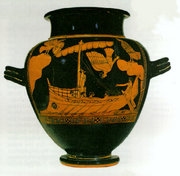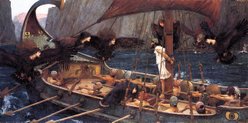
Sirens
From Wikipedia, the free encyclopedia
A Greek amphora depicting Odysseus' encounter with the sirens
In Greek mythology, the Sirens or Seirenes (were Naiads (sea nymphs) who lived on an island called Sirenum scopuli which was surrounded by cliffs and rocks. Approaching sailors were drawn to them by their enchanting singing, causing them to sail on the cliffs and drown. They were considered the daughters of Achelous (by Terpsichore, Melpomene or Sterope) or Phorcys (Virgil. V. 846; Ovid XIV, 88). Their number is variously reported as between two and five, and their individual names as Thelxiepia/Thelxiope/Thelxinoe, Molpe, Aglaophonos/Aglaope, Pisinoe/Peisinoë, Parthenope, Ligeia, Leucosia, Raidne, and Teles. According to some versions, they were playmates of young Persephone and were changed into the monsters of lore by Demeter for failing to intervene when Persephone was abducted (Ovid V, 551).
The term "siren song" refers to an appeal that is hard to resist but that, if heeded, will lead to a bad result.
In early art, the Sirens were represented as birds with the heads, and sometimes the chests, of women. Later, they were represented as female figures with the legs of birds, with or without wings. The 10th century encyclopedia Suda [1] says that from their chests up Sirens had the form of sparrows, below they were women, or, alternatively, that they were little birds with women's faces.
Birds were chosen because of their characteristic beautiful voice. However, later in history Sirens were sometimes also depicted as beautiful women (whose bodies, not only their voices, are seductive), or even as mermaids (half woman, half fish). The fact that in some languages (such as French or Italian) the word for mermaid is Siren or Sirena adds to this confusion.
Encounters with the Sirens

Ulysses and the Sirens. A 1891 painting by John William Waterhouse.
Odysseus escaped the Sirens by having all his sailors plug their ears with beeswax and tie him to the mast. He was curious as to what the Sirens sounded like. When he heard their beautiful song, he ordered the sailors to untie him but they ignored him. When they had passed out of earshot, Odysseus stopped thrashing about and calmed down, and was released (Odyssey XII, 39).
Jason had been warned by Chiron that Orpheus would be necessary in his journey. When Orpheus heard their voices, he drew his lyre and played his music more beautifully than they, drowning out their voices.
It is said that after a ship successfully sailed by the Sirens, they drowned themselves for their failure. Varying traditions associate this event with their encounters with Jason or Odysseus.
Popular culture
Elle MacPherson, Portia di Rossi and Kate Fischer starred as sirens alongside Hugh Grant,
Tara Fitzgerald and Sam Neill in John Duigan's Sirens (1994) a mildly erotic comedy. The basic (fictional) plotline being that a young English clergyman and his wife are drawn into an enticing world of lascivious art while attempting to persuade the genuine Australian artist Norman Lindsay (played in the film by Sam Neill) to withdraw a controversial work of art from an upcoming exhibition.
Once on the artist's estate, however, the couple find themselves increasingly drawn into a more sexually liberated world by Lindsay's family and his three beautiful models.
Three "Sirens" were featured in the 2000 film O Brother, Where Art Thou?
Tim Buckley wrote and performed a song called Song to the Siren which has been covered by many artists including, perhaps most famously, the Cocteau Twins.
A GF (Guardian Force) in the RPG Final Fantasy VIII was named "Siren", whose attack is called "Silent Voice".
An episode of the BBC comedy Red Dwarf entitled Psirens featured repulsive creatures who could create the illusion they were beautiful women. They did this hoping to lure unwary travellers to them so they could suck out their brains with a straw.
In the video game series Star Control, one alien species is a race of beautiful blue women named "Syreens", an obvious play on words. Also, their ships can use mind-control to beckon crew from enemy ships to work on their ships.
In Terry Brooks' 'Shannara' series there is a species of carnivorous plant called 'Sirens' that grows on the Battlemounds in the Eastlands. The plants have poison thorns which they are capable of launching at prey. They lure their prey within reach with an illusion of a beautiful woman singing.
The heavy metal band Nightwish also has a song called "The Siren," which depicts a man being tied to the wheels of his ship by the beautiful siren of the sea.
The characters Elle, Flamesh and Monique of the RPG Legend of Mana are sirens. Flamesh is a mermaid, while Elle and Monique are birdlike from the waist down and have wings (though Monique's are decidedly more plantlike than birdlike). Elle (the only playable siren) suffered grief when she realised that her singing had caused the crashing of a ship and vowed to never sing again, until her friends convinced her that she should not be ashamed of her nature as a siren. Monique is known for singing to unseen fairies to have them magically light the lamps she crafts.
On the Starbucks logo, they feature a picture of a Siren in the center.
In the comic strip Foxtrot. Paige is represented as a Siren in Peter's dream of the Odyssey.
In The Simpsons, Odyssesus (Homer Simpson) and his crew are sailing by and hear an enchanting song. They imagine that the women singing would be gorgeous nymphs. Unfotunately, it turns out that the "gorgeous maidens" are Homer's very unattractive twin sisters-in-law. When the crew sees them, they gasp out of shock and disgust and sail away as quickly as possible.
The Sirens is featured in Radiohead's first single, There There, from their fifth album, Hail to the Thief.
